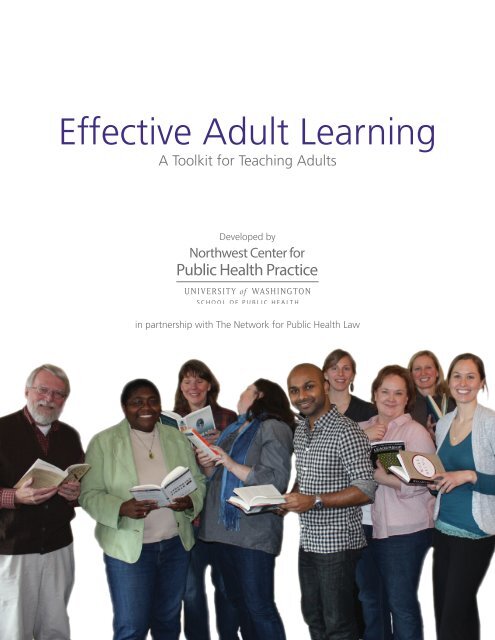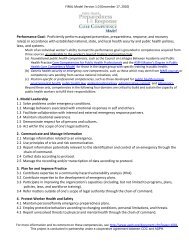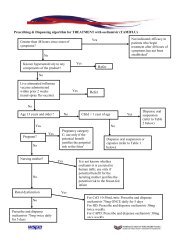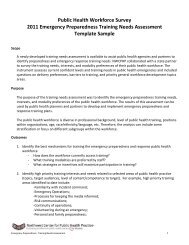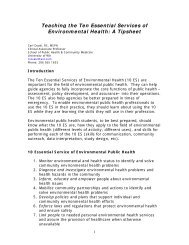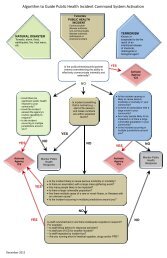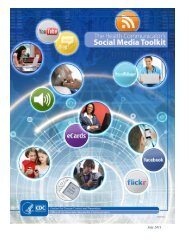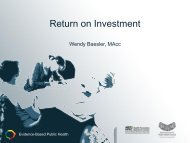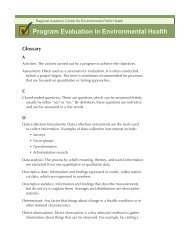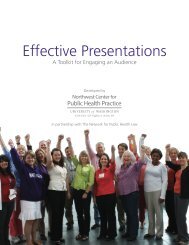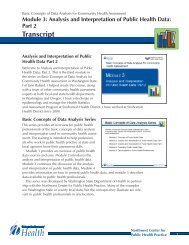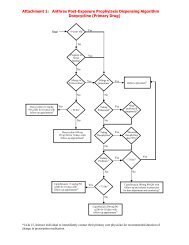Effective Adult Learning - Northwest Center for Public Health Practice
Effective Adult Learning - Northwest Center for Public Health Practice
Effective Adult Learning - Northwest Center for Public Health Practice
You also want an ePaper? Increase the reach of your titles
YUMPU automatically turns print PDFs into web optimized ePapers that Google loves.
<strong>Effective</strong> <strong>Adult</strong> <strong>Learning</strong><br />
A Toolkit <strong>for</strong> Teaching <strong>Adult</strong>s<br />
Developed by<br />
in partnership with The Network <strong>for</strong> <strong>Public</strong> <strong>Health</strong> Law
Developed in 2012 by<br />
in partnership with<br />
Design updated in 2014. Please send any comments or questions to the <strong>Northwest</strong> <strong>Center</strong> <strong>for</strong><br />
<strong>Public</strong> <strong>Health</strong> <strong>Practice</strong> at the University of Washington School of <strong>Public</strong> <strong>Health</strong>.<br />
www.nwcphp.org<br />
This toolkit is one of a series funded by the Robert Wood Johnson Foundation<br />
to support the development of trainings in public health law.
<strong>Effective</strong> <strong>Adult</strong> <strong>Learning</strong><br />
A Toolkit <strong>for</strong> Teaching <strong>Adult</strong>s<br />
The aim of this toolkit is to help you put together effective learning <strong>for</strong> adults. Intermediateor<br />
advanced-level users may choose to scan the sidebars as reminders to use when developing<br />
instruction, rather than reading the full text. This toolkit contains four sections:<br />
I. <strong>Adult</strong> <strong>Learning</strong> Overview<br />
Getting Started<br />
Defining your audience, purpose, learning objectives, methods <strong>for</strong> delivery, and class size.<br />
Developing Training Content<br />
Common questions and answers about materials, choosing instructional methods, and how to<br />
put it all together.<br />
Delivering Your Training<br />
Background on using the Cone of <strong>Learning</strong>, tips on facilitating effectively, and 10 important<br />
lessons <strong>for</strong> presenters.<br />
II. <strong>Learning</strong> Objectives In-Depth<br />
Be<strong>for</strong>e and After<br />
Examples of well written and poorly written learning objectives.<br />
Writing <strong>Learning</strong> Objectives<br />
More detail on how to write objectives and avoid common mistakes.<br />
III. Tools and Templates<br />
Tools and templates to help you create better trainings.<br />
IV. References<br />
A short matrix of practical and classic theory references, with annotation.
Introduction<br />
You don’t need a degree in adult education to create<br />
excellent training courses. Follow the guidelines in this<br />
document, and you can develop trainings like a pro.<br />
What’s Different About Teaching<br />
<strong>Adult</strong>s?<br />
To be effective in teaching adults, it’s important to know<br />
your audience and have a general understanding of how<br />
adults learn. Much has been written about the topic, and<br />
you can find suggestions <strong>for</strong> additional reading in Section 4:<br />
References.<br />
To best reach adults, there are five key factors you should<br />
focus on in the development of your training:<br />
1. The material presented should have immediate<br />
usefulness to the learners.<br />
2. The material presented should be relevant to adult<br />
learners’ lives.<br />
3. The training environment should be welcoming so<br />
that all learners feel safe to participate.<br />
4. The training presentation should be engaging.<br />
5. The training should be presented in a respectful<br />
manner, where learners have an opportunity to share<br />
their experiences.<br />
Following these key principles will help you determine what<br />
to include in your training and how to present it. Make your<br />
training relevant to the learner by recognizing the unique<br />
background and experience of people working in public<br />
health. To engage your audience, use examples or anecdotes<br />
showing how the material is relevant.<br />
How to Reach <strong>Adult</strong><br />
Learners<br />
You want to connect with<br />
your adult audience. Make<br />
sure your course is:<br />
• Immediately useful<br />
• Relevant<br />
• Welcoming<br />
• Engaging<br />
• Respectful<br />
Make Connections<br />
Stories, cases, and<br />
anecdotes help make<br />
connections.<br />
Do you have a story<br />
related to your topic<br />
ready to share with your<br />
audience?<br />
(Adapted from Knowles, M.L., The <strong>Adult</strong> Learner 6th ed., 2005)<br />
www.nwcphp.org <strong>Effective</strong> <strong>Adult</strong> <strong>Learning</strong>: A Toolkit <strong>for</strong> Teaching <strong>Adult</strong>s | 4
<strong>Adult</strong> <strong>Learning</strong> Overview<br />
1. Getting Started<br />
2. Developing Training Content<br />
3. Delivering Your Training<br />
1. Getting Started<br />
There are many ways to develop instruction, and educators<br />
have frequently debated which ways are the most effective.<br />
One practical approach that works well with adult learners<br />
shifts the thinking about developing instruction from “what<br />
will you teach,” to “what do the students need to learn?”<br />
This change of perspective will help the development<br />
process immensely.<br />
To get started, you first need to be able to answer several<br />
key questions addressed in this section.<br />
Who is my target audience, and what are their learning<br />
needs?<br />
It is your responsibility as an instructor to find out who<br />
will be in the audience and what kind of training they<br />
have already received. It is also helpful to write a short<br />
description of your target audience. You can use this when<br />
disseminating in<strong>for</strong>mation about your course.<br />
Try to at least to learn the answers to these three questions:<br />
• Who are you going to teach? Get names and titles<br />
of your attendees, or at least the names of their<br />
places of employment.<br />
• What is their background? If you can determine<br />
the students’ educational backgrounds, this will help<br />
in determining the depth of in<strong>for</strong>mation to cover in<br />
your class.<br />
• Will some people need more training than<br />
others? In cases where there are extreme differences<br />
in skill levels, you might consider holding several<br />
Key Questions<br />
• Who is my target<br />
audience, and what are<br />
their learning needs?<br />
• What are the learning<br />
objectives <strong>for</strong> this<br />
training?<br />
• What kind of training<br />
should I develop?<br />
• How large should my<br />
class be?<br />
Target Audience<br />
Target audience<br />
descriptions do not need<br />
to be extensive, but they<br />
should be very specific.<br />
For example, “The<br />
primary audience is<br />
governmental public<br />
health leadership and<br />
practitioners without<br />
<strong>for</strong>mal legal training.”<br />
www.nwcphp.org <strong>Effective</strong> <strong>Adult</strong> <strong>Learning</strong>: A Toolkit <strong>for</strong> Teaching <strong>Adult</strong>s | 5
sessions at different levels of expertise—<strong>for</strong><br />
frontline workers versus managers, <strong>for</strong> example.<br />
Ideally, you should conduct a needs assessment prior to<br />
taking on a training project. This helps to identify gaps in<br />
learning and further targets the training <strong>for</strong> your audience.<br />
See Section 3: Tools and Templates, <strong>for</strong> a worksheet to help<br />
you do this.<br />
What are the learning objectives <strong>for</strong> this training?<br />
Your purpose should meld the key components of your<br />
audience, its training needs, its skill and knowledge deficits,<br />
and what you want to accomplish in your course. Think<br />
through what you want participants to learn as a result<br />
of your training. They should leave the training with new<br />
in<strong>for</strong>mation and/or skills that they didn’t possess prior to<br />
taking it.<br />
<strong>Learning</strong> objectives serve as a type of contract with your<br />
audience and help put the purpose of your training in<br />
concrete, measurable terms. If participants know the<br />
objectives from the beginning, they know what they are<br />
expected to learn. Objectives also clearly focus on the<br />
desired outcomes.<br />
Be<strong>for</strong>e you start developing your learning objectives,<br />
it’s important to determine the kind of learning your<br />
students will be gaining. Identifying the type of learning—<br />
Knowledge, Skills or Attitudes (KSAs)—will help you<br />
develop more specific learning objectives.<br />
For example, if your students’ learning involves knowledge<br />
retention and the development of intellectual skills, it is<br />
considered knowledge-based. If your students’ learning<br />
involves physical movement, coordination, and motor skills,<br />
it is considered skill-based. If your students’ learning deals<br />
with things emotionally like motivation and values, it is<br />
considered attitudes-based.<br />
Training Purpose<br />
The purpose of your<br />
training should be<br />
anchored in:<br />
• Training needs<br />
• Skill, knowledge deficits<br />
• What participants<br />
should know<br />
Types of <strong>Learning</strong><br />
Types of learning fall into<br />
three categories:<br />
• Knowledge: specific<br />
facts, patterns, concepts<br />
• Skills: practical abilities<br />
measured in speed,<br />
precision<br />
• Attitudes: realizing<br />
feelings, values,<br />
motivation<br />
www.nwcphp.org <strong>Effective</strong> <strong>Adult</strong> <strong>Learning</strong>: A Toolkit <strong>for</strong> Teaching <strong>Adult</strong>s | 6
How do I develop learning objectives?<br />
Developing effective objectives that get to the purpose of<br />
your training is not easy. But you can do it by following a<br />
few simple steps. Objectives should be written from the<br />
participants’ point of view. They should emphasize what<br />
you want students to value, understand or do with the<br />
in<strong>for</strong>mation or skills being taught.<br />
According to Robert Mager, a world-renowned expert<br />
in instructional design, the simplest way to start writing<br />
learning objectives is by answering three questions:<br />
1. What will participants be able to do as a result of the<br />
course, training, or class?<br />
2. What are the conditions or circumstances where<br />
the participants will per<strong>for</strong>m this activity, and what<br />
knowledge or materials does he/she need to do this<br />
effectively?<br />
3. What level of proficiency is needed to per<strong>for</strong>m the<br />
task or skill successfully or apply this in<strong>for</strong>mation?<br />
There are several different models that have been created<br />
to help in designing learning objectives. For developing<br />
practical objectives, you might consider the SMART Model.<br />
For considering objectives that may relate more to behavior<br />
change, you might consider the A-B-C-D Model.<br />
See Section 2: <strong>Learning</strong> Objectives In-Depth, <strong>for</strong> more<br />
detail on how to write effective objectives and to see<br />
“be<strong>for</strong>e” and “after” examples.<br />
What kind of training should I develop?<br />
Will it be a one-time course or a series? Will it be face-toface,<br />
online, or blended? How intensive, basic, or elaborate<br />
your training will be depends on determining the following:<br />
• What resources are available?<br />
• What are some potential challenges to this training<br />
(<strong>for</strong> example, <strong>for</strong>mat, class size, minimal resources)?<br />
• What content needs to be created?<br />
<strong>Learning</strong> Objective<br />
Tips<br />
SMART Model<br />
This model is used to<br />
build practical objectives.<br />
S is <strong>for</strong> Specific; specify<br />
what to achieve.<br />
M is <strong>for</strong> Measurable.<br />
A is <strong>for</strong> Achievable.<br />
R is <strong>for</strong> Relevant.<br />
T is <strong>for</strong> Time-bound.<br />
A-B-C-D Model<br />
This model is often<br />
used to build behavioral<br />
objectives.<br />
A is <strong>for</strong> Audience. State<br />
the learning audience<br />
within the objective.<br />
B is <strong>for</strong> Behavior. State<br />
the behavior you wish to<br />
see exhibited.<br />
C is <strong>for</strong> Condition. State<br />
the conditions where the<br />
behavior will occur.<br />
D is <strong>for</strong> Degree. To what<br />
degree will the learner be<br />
enabled?<br />
• What evaluation instruments need to be created?<br />
www.nwcphp.org <strong>Effective</strong> <strong>Adult</strong> <strong>Learning</strong>: A Toolkit <strong>for</strong> Teaching <strong>Adult</strong>s | 7
The content and activities appropriate <strong>for</strong> your course<br />
should be tied directly to the learning needs and objectives<br />
that you have defined. To be most effective, they should be<br />
tailored to your audience.<br />
How large should my class be?<br />
Based on current literature, the best class size estimate is<br />
approximately 15 students per classroom if you are teaching<br />
face-to-face, although debate still rages around a specific<br />
number. Smaller class sizes make it easier to break into<br />
groups or work on activities and use other learning methods<br />
besides lecture.<br />
Higher order thinking skills tend to be learned most<br />
effectively by creating, evaluating, and analyzing content.<br />
Keep in mind that the more complex your material, the<br />
more time and activities you may need to provide your<br />
students, so they have plenty of opportunities to grasp the<br />
complexities.<br />
Higher Order Thinking Skills<br />
Creating<br />
Evaluating<br />
Analyzing<br />
Applying<br />
Understanding<br />
Remembering<br />
Lower Order Thinking Skills<br />
Class Size and<br />
Thinking Skills<br />
Higher order thinking<br />
skills, like creating,<br />
evaluating, and analyzing,<br />
can be attained more<br />
easily in smaller classes<br />
with group activities.<br />
Lower order thinking<br />
skills, like memorizing<br />
and remembering, need<br />
less interaction. Thus,<br />
they aren’t as tied to class<br />
size.<br />
(Courtesy: Churches, A. Educator’s eZine,<br />
April 2008)<br />
www.nwcphp.org <strong>Effective</strong> <strong>Adult</strong> <strong>Learning</strong>: A Toolkit <strong>for</strong> Teaching <strong>Adult</strong>s | 8
2. Developing Training Content<br />
How do I develop training materials?<br />
Developing training materials involves writing, creating<br />
learning exercises, and working with content experts and<br />
trainers. It is the most time-consuming phase, but it is also<br />
key to making sure your training is successful. Well designed,<br />
direct materials help drive your training and rein<strong>for</strong>ce your<br />
learning objectives and outcomes.<br />
You may have your draft materials reviewed by several<br />
people, and they may go through a number of revisions.<br />
Make sure the materials match the learning outcomes you<br />
identified, based on your assessment of the needs of your<br />
learners.<br />
Key Questions<br />
• How do I develop<br />
training materials?<br />
• How do I choose<br />
instructional methods?<br />
• How do I put it all<br />
together in a course?<br />
• How do I create a<br />
trainer’s manual?<br />
A basic way to pull together materials and/or related<br />
activities is to use your own experience as a learner.<br />
Complete the process below <strong>for</strong> each of your learning<br />
objectives <strong>for</strong> the course or training:<br />
1. Identify one of your clearly stated learning<br />
objectives.<br />
2. Determine what kind of learning domain the<br />
outcome involves (knowledge, skill, or attitude).<br />
3. Choose an instructional method (activity, handout,<br />
team project, etc.) This helps participants<br />
accomplish your stated learning objective by doing.<br />
4. Explain how this learning experience will help your<br />
students meet the learning objectives you have<br />
identified.<br />
How do I choose instructional methods?<br />
There are a number of instructional methods to choose<br />
from when designing your materials. See Section 3: Tools<br />
and Templates, <strong>for</strong> a learning interventions worksheet to<br />
help you do this.<br />
Listed below are some key methods, including purpose and<br />
when to use them:<br />
Methods of<br />
Instruction<br />
Group activities<br />
• Role plays<br />
• Simulations<br />
• Games<br />
Individual<br />
• Self-assessments<br />
• Evaluations<br />
• Writing<br />
Either<br />
• Case studies<br />
• Projects<br />
Case studies, role plays, and small group discussions<br />
www.nwcphp.org <strong>Effective</strong> <strong>Adult</strong> <strong>Learning</strong>: A Toolkit <strong>for</strong> Teaching <strong>Adult</strong>s | 9
help participants discover learning points themselves and<br />
practice skills used in interactions. Best used to practice<br />
newly acquired skill, to experience what a particular situation<br />
feels like, to provide feedback to participants or to apply<br />
new knowledge to a specific situation, practice problemsolving<br />
skills.<br />
Classroom training, lectures, and lecturettes convey<br />
in<strong>for</strong>mation when interaction or discussion is not desired or<br />
possible. Best used to convey in<strong>for</strong>mation in a short time,<br />
to communicate the same in<strong>for</strong>mation to large numbers of<br />
people, or to provide basic in<strong>for</strong>mation to a group.<br />
Experiential learning lets participants try new concepts,<br />
processes or systems in a controlled environment through<br />
supervised coaching, practicum or internship which includes<br />
debriefing and reflection. Best used in structured and<br />
mentored settings.<br />
Games, table-tops, and simulations provide nonthreatening<br />
ways to present or review course material<br />
and can be used to recreate a process, event or set of<br />
circumstances, usually complex, so that participants can<br />
experience and manipulate the situation without risk and<br />
then analyze what happened. Best used to integrate and<br />
apply complex skills, to elicit participants’ natural tendencies<br />
and provide feedback, to provide a realistic job-related<br />
experience, to help grasp total program content, to present<br />
dry material in an interesting way or to add a competitive<br />
element to a session.<br />
Projects and writing tasks help participants reflect on<br />
their understand of concepts, in<strong>for</strong>mation, ideas and allow<br />
them to work individually or in small groups with the<br />
content. Best used to test <strong>for</strong> participants understanding or<br />
to provide <strong>for</strong> individual input.<br />
Self-study allows an individual to acquire skills and<br />
knowledge through self-learning, guided by structured<br />
materials. Best used as computer-based modules, CD-ROM/<br />
DVD learning, and web-based virtual labs.<br />
www.nwcphp.org <strong>Effective</strong> <strong>Adult</strong> <strong>Learning</strong>: A Toolkit <strong>for</strong> Teaching <strong>Adult</strong>s | 10
How do I put it all together <strong>for</strong> a course?<br />
You have learned about your audience, assessed their needs,<br />
developed learning objectives, determined the type of<br />
training, and developed training materials. Now it’s time to<br />
put it all together in a course.<br />
See Section 3: Tools and Templates, <strong>for</strong> a worksheet to help<br />
you do this, or you can follow these simple steps:<br />
1. Prepare a course outline with what needs to be<br />
learned and time allotted. Clearly name the content<br />
(knowledge, skills, or attitudes) and learning<br />
objectives. Make sure your learning is sequenced,<br />
with easier learning first, building to complex.<br />
2. Determine work-related professional competencies,<br />
capabilities or standards your course addresses, if<br />
applicable. See sidebar, “<strong>Public</strong> <strong>Health</strong> Standards &<br />
Competencies” on this page <strong>for</strong> you competencies<br />
to consider. Note these competencies in materials<br />
you disseminate with your course.<br />
3. Develop how learning will be evaluated. Will you<br />
include an assessment of some type? (Examples<br />
include a quiz, test, or final project.)<br />
4. Develop a trainer’s manual or instruction sheet <strong>for</strong><br />
yourself (see page 19 <strong>for</strong> more in<strong>for</strong>mation), and a<br />
syllabus denoting what the class will cover <strong>for</strong> your<br />
students. Provide this to participants in advance if<br />
possible.<br />
5. Include a warm-up exercise, appropriate <strong>for</strong> the<br />
group and setting.<br />
6. Plan <strong>for</strong> open questions and ways to stimulate<br />
discussion throughout the course.<br />
7. Make your course design flexible, providing options<br />
<strong>for</strong> assignments, to help meet different learning<br />
styles.<br />
8. Set up activities that ensure the inclusion of all<br />
participants.<br />
9. Provide follow-up—resources, books, contact names<br />
and numbers, websites—to rein<strong>for</strong>ce learning.<br />
Course Elements<br />
• Course outline, learning<br />
objectives<br />
• Competencies, if<br />
desired<br />
• Evaluation tool<br />
• Trainer’s instructions<br />
• Student syllabus<br />
• Warm-up exercise<br />
• Question periods<br />
• Flexible and inclusive<br />
activities<br />
• Resources<br />
<strong>Public</strong> <strong>Health</strong><br />
Standards and<br />
Competencies<br />
These resources may be<br />
helpful to consider <strong>for</strong><br />
public health courses.<br />
Click the links to see each<br />
set.<br />
• Core Competencies <strong>for</strong><br />
<strong>Public</strong> <strong>Health</strong> Professionals<br />
• <strong>Public</strong> <strong>Health</strong> Preparedness<br />
& Response Core<br />
Competency Model<br />
• <strong>Public</strong> <strong>Health</strong> Preparedness<br />
Capabilities: National<br />
Standards <strong>for</strong> State and<br />
Local Planning<br />
www.nwcphp.org <strong>Effective</strong> <strong>Adult</strong> <strong>Learning</strong>: A Toolkit <strong>for</strong> Teaching <strong>Adult</strong>s | 11
How do I create a trainer’s manual or instruction sheet?<br />
Depending on the type of training you are developing, it may be useful to produce a simple trainer’s<br />
manual or instruction sheet. This is useful to guide the delivery process <strong>for</strong> the trainer of the<br />
curriculum, including how to prepare <strong>for</strong> the training, gathering materials, lesson planning, etc. See a<br />
sample of a simple trainer’s instruction sheet <strong>for</strong> a short course below.<br />
Example: Instruction Sheet <strong>for</strong> Trainers<br />
Unit 1 - Workshop: Establishing Rapport and Understanding<br />
During this unit, participants—whether they already know each other or not—will get to<br />
know each other in various ways. Introductions will help establish a group identity and give<br />
everyone a chance to state their training needs and expectations. Participants will explore<br />
how people might perceive health care roles and responsibilities quite differently than others<br />
do; and how that might impact teamwork and patient care.<br />
Trainer Goals<br />
• Help participants get to know each other and develop trust.<br />
• Identify what participants want to get out of the training.<br />
• Increase participants’ understanding of basic communication skills.<br />
<strong>Learning</strong> Objectives<br />
Participants will be able to:<br />
• Express their training needs in regard to the training topic.<br />
• Better understand the roles others play.<br />
• Understand any false assumptions they had about other people’s work responsibilities<br />
and per<strong>for</strong>mance.<br />
• Use at least one new communication tool.<br />
Unit Outline<br />
Time Activity Focus<br />
5 minutes #1: Presentation Introductions and learning objectives<br />
15 minutes #2: Large group discussion Participants identify themselves and their<br />
training needs and expectations<br />
35 minutes #3: Small group discussion of<br />
roles/large group follow-up<br />
The assumptions (sometimes false)<br />
professionals can make about the roles of<br />
others and the problems this can cause in<br />
communication, teamwork<br />
25 minutes #4: Large group exercise Enhanced communication skills<br />
www.nwcphp.org <strong>Effective</strong> <strong>Adult</strong> <strong>Learning</strong>: A Toolkit <strong>for</strong> Teaching <strong>Adult</strong>s | 12
3. Delivering Your Training<br />
How do I increase retention?<br />
People often remember more when they practice or use<br />
their learning compared to when they just read or hear<br />
in<strong>for</strong>mation. The amount of in<strong>for</strong>mation we remember is in<br />
direct proportion to the amount of involvement we had in<br />
the learning.<br />
The Cone of <strong>Learning</strong> (see figure below) shows that we<br />
tend to remember only about 10 percent of what we read.<br />
Our memory increases when we hear and see something<br />
together—like watching a movie or going to an exhibit.<br />
We remember about 90 percent of what we say and do,<br />
like practicing what we learned. This is important <strong>for</strong> you<br />
to recognize as you deliver training to your adult learners.<br />
Choosing the appropriate methods <strong>for</strong> delivery is critical in<br />
increasing retention.<br />
The Cone of <strong>Learning</strong><br />
Key Questions<br />
• How do I increase<br />
retention?<br />
• What delivery method<br />
should I use?<br />
• How do I facilitate<br />
effectively in the<br />
classroom?<br />
After two weeks,<br />
we tend to remember...<br />
Reading<br />
Hearing words<br />
Seeing<br />
Watching a movie,<br />
Seeing an exhibit,<br />
Watching a demonstration,<br />
Seeing it done on location<br />
Participating in discussion,<br />
Giving a talk<br />
Doing a dramatic presentation,<br />
Simulating the real experience,<br />
Doing the real thing<br />
10% of what we READ<br />
20% of what we HEAR<br />
30% of what we SEE<br />
50% of what we SEE & HEAR<br />
70% of what we SAY<br />
90% of what we DO<br />
Active Passive<br />
(Based on the research of Edgar Dale, originator of “The Cone of <strong>Learning</strong>.”)<br />
www.nwcphp.org <strong>Effective</strong> <strong>Adult</strong> <strong>Learning</strong>: A Toolkit <strong>for</strong> Teaching <strong>Adult</strong>s | 13
What delivery method should I use?<br />
There are many ways to deliver your training, depending on the type of learning you are developing.<br />
Below are a few of the key methods and some pros and cons of using them.<br />
Delivery Method Description Advantages Disadvantages<br />
In-person learning Classroom setting,<br />
traditional, <strong>for</strong>mal<br />
learning<br />
<strong>Effective</strong> when sharing<br />
in<strong>for</strong>mation with large<br />
group, build bonds<br />
Establishes a “tell-me”<br />
mindset, places burden of<br />
learning on teacher<br />
E-learning<br />
Computer-based,<br />
often distance-based<br />
Provides training when<br />
learners need it, flexible<br />
Loss of personal contact,<br />
computer-based tasks can<br />
be time-consuming <strong>for</strong><br />
some, issues of access <strong>for</strong><br />
those with disabilities<br />
Problem-based<br />
learning<br />
Problem comes first<br />
and learners work<br />
through it, often in<br />
teams<br />
Actively involves<br />
participants, stimulates<br />
peer group learning,<br />
promotes critical<br />
thinking<br />
Can lose focus, can<br />
challenge inclusivity of<br />
group, can be difficult if<br />
there is a wide variety of<br />
skill sets among members<br />
Blended learning<br />
A hybrid of<br />
in-person and<br />
e-learning<br />
Combines the best<br />
from multiple types of<br />
delivery methods<br />
May be difficult <strong>for</strong><br />
some learners to follow,<br />
may need additional<br />
rein<strong>for</strong>cement to stay on<br />
task<br />
Non-<strong>for</strong>mal<br />
learning<br />
Most closely<br />
associated with<br />
skill or certificate<br />
programs<br />
Structured learning<br />
environment,<br />
intentional to specific<br />
skills, or professional<br />
development<br />
Often takes places<br />
outside of an academic<br />
organization, may not lead<br />
to recognized certification<br />
or licensure<br />
(Adapted from the ASTD handbook <strong>for</strong> workplace learning professionals, 2008.)<br />
How do I facilitate effectively in the classroom?<br />
How effectively your course is received depends largely on the learning atmosphere you set up and<br />
model <strong>for</strong> your participants.<br />
Support your participants by building an atmosphere of trust. Model a positive attitude, and provide<br />
constructive and supportive feedback. For example, you might say, “That’s a very good example of<br />
the concept we are discussing.”<br />
www.nwcphp.org <strong>Effective</strong> <strong>Adult</strong> <strong>Learning</strong>: A Toolkit <strong>for</strong> Teaching <strong>Adult</strong>s | 14
Ensure the entire course content is covered. It is important<br />
to stick to a schedule and do what you say you will do. If<br />
participants deviate from the topic, create a “parking lot” <strong>for</strong><br />
additional topics that come up. Arrange <strong>for</strong> a separate time<br />
to take those up (at a break, or designated review period).<br />
Model effective facilitation skills by asking open-ended<br />
questions and rephrasing participants’ comments accurately<br />
<strong>for</strong> clarity, when needed. Respect every person’s feelings,<br />
perspectives, and contributions.<br />
10 important lessons <strong>for</strong> effective classroom<br />
presentations<br />
Capturing the attention of an in-person class takes skill.<br />
Bob Pike, a nationally known trainer, provides some advice<br />
learned from seasoned professionals.<br />
1. Don’t talk at participants. Involve them.<br />
2. Encourage positive group dynamics. Re<strong>for</strong>m and<br />
move students into groups as needed.<br />
Facilitation Tips<br />
• Build trust<br />
• Model positive attitude<br />
• Give supportive<br />
feedback<br />
• Stick to a schedule<br />
• Create a “parking lot”<br />
<strong>for</strong> deviations off topic<br />
• Ask open-ended<br />
questions<br />
• Respect every student’s<br />
feelings<br />
3. Allow participants to discover data <strong>for</strong> themselves.<br />
4. Ask participants to keep an action or idea list, and<br />
revisit it throughout the session.<br />
5. <strong>Learning</strong> is directly proportionate to the amount of<br />
fun you have.<br />
6. Change the pace. Listening with retention only lasts<br />
about 20 minutes at a time.<br />
7. Design your class so participants leave impressed<br />
with themselves and what they learned.<br />
8. Allow adults learners to use their expertise by leaving<br />
time to share experiences.<br />
9. Don’t offer material only one way. Recognize your<br />
participants will learn differently.<br />
10. Teach the things you have a passion <strong>for</strong>!<br />
Resolving Class<br />
Conflicts<br />
• Agree to class rules<br />
early on<br />
• Teach and model<br />
the right thing to do,<br />
set norms <strong>for</strong> your<br />
classroom<br />
• Shut down unhealthy<br />
conversations and<br />
inappropriate behavior<br />
immediately<br />
• Redirect back to the<br />
subject at hand, take the<br />
focus off the negativity<br />
www.nwcphp.org <strong>Effective</strong> <strong>Adult</strong> <strong>Learning</strong>: A Toolkit <strong>for</strong> Teaching <strong>Adult</strong>s | 15
2. <strong>Learning</strong> Objectives In-Depth<br />
1. Be<strong>for</strong>e and After <strong>Learning</strong> Objectives<br />
2. Writing <strong>Learning</strong> Objectives<br />
1. Be<strong>for</strong>e and After <strong>Learning</strong> Objectives<br />
While writing learning objectives may seem like a small task, if you design them poorly, it will be<br />
more difficult to produce an effective training and almost impossible to measure results. Below is an<br />
example of “be<strong>for</strong>e” and “after” learning objectives to help contrast the differences.<br />
Let’s assume that we are creating a training program <strong>for</strong> receptionists. The goal of the program is<br />
simply to train people in proper phone use. What might the specific tasks and associated learning<br />
objectives include?<br />
“Be<strong>for</strong>e” learning objectives<br />
(poorly defined)<br />
After completing this course you will be able to:<br />
• Operate your phone<br />
• Know how to greet callers<br />
• Understand the call transferring procedure<br />
“After” learning objectives<br />
(well defined)<br />
After completing this course you will be able to:<br />
• Place a caller on hold<br />
• Activate the speaker phone<br />
• Play new messages on the voice mail system<br />
• List the three elements of a proper phone<br />
greeting<br />
• Transfer a call to a requested extension<br />
These objectives do not indicate observable<br />
behaviors, making assessment of their mastery<br />
impossible.<br />
How does one know if someone knows or<br />
understands something? What does it really mean<br />
to operate the phone?<br />
These objectives are built around very discrete<br />
tasks. Instead of the vague objective to “operate<br />
the phone,” the learner knows exactly what is<br />
expected <strong>for</strong> successful operation— namely, using<br />
the hold feature, speakerphone, and voice mail<br />
system. More importantly, these behaviors are<br />
observable.<br />
Adapted from “How to Write Great <strong>Learning</strong> Objectives,” by Kevin Kruse<br />
www.nwcphp.org <strong>Effective</strong> <strong>Adult</strong> <strong>Learning</strong>: A Toolkit <strong>for</strong> Teaching <strong>Adult</strong>s | 16
Let’s look at another example of a poorly defined set of learning objectives and their improved, well<br />
defined counterparts. The following objectives were developed <strong>for</strong> a public health law course.<br />
“Be<strong>for</strong>e” learning objectives<br />
(poorly defined)<br />
After completing this course you will be able to:<br />
• Be aware of legal terms.<br />
• Improve working relationships with lawyers.<br />
• Have an increased awareness of public health<br />
law.<br />
“After” learning objectives<br />
(well defined)<br />
After completing this course you will be able to:<br />
• Recognize legal issues.<br />
• Formulate legal questions.<br />
• Implement effective strategies <strong>for</strong> working with<br />
legal counsel.<br />
• Describe key principles of public health law.<br />
• Identify key public health laws that govern<br />
leadership’s responsibilities, authority, and<br />
limitations.<br />
These objectives do not indicate observable<br />
behaviors, making assessment of their mastery<br />
impossible.<br />
How does one know if someone knows or is<br />
aware of something? What does it really mean to<br />
improve working relationships?<br />
These objectives are measurable as they are built<br />
around tasks. Instead of the vague objective to<br />
“be aware of legal terms,” the learner knows<br />
exactly what is expected. Rather than seeking<br />
“an increased awareness of public health law,”<br />
the course is asking the student to “describe key<br />
principles of public health law and identify those<br />
that govern leadership’s responsibilities, authority<br />
and limitations.”<br />
The following learning objectives are from a legal course dealing with minor consent, confidentiality<br />
and mandatory reporting:<br />
“Be<strong>for</strong>e” learning objectives<br />
(poorly defined)<br />
After completing this course you will be able to:<br />
• List what is meant by consent.<br />
• Identify requirements <strong>for</strong> agencies.<br />
• Be able to explain confidentiality.<br />
“After” learning objectives<br />
(well defined)<br />
After completing this course you will be able to:<br />
• List four types of health care to which minors<br />
are able to consent.<br />
• State requirements of Title X agencies <strong>for</strong><br />
providing reproductive health services to<br />
minors.<br />
• Describe the role of confidentiality in<br />
providing health care to minors.<br />
www.nwcphp.org <strong>Effective</strong> <strong>Adult</strong> <strong>Learning</strong>: A Toolkit <strong>for</strong> Teaching <strong>Adult</strong>s | 17
2. Writing <strong>Learning</strong> Objectives<br />
Educators have used learning, or behavioral, objectives<br />
<strong>for</strong> at least four decades. Today, the use of objectives has<br />
become routine in education and many national accrediting<br />
organizations recommend using them. Objectives are not<br />
difficult to write if you follow the guidelines below.<br />
Benefits of incorporating objectives within your coursework<br />
include: emphasis of major points and reduction of nonessential<br />
material, simplification of note taking, cueing the<br />
students to emphasize major points, assistance in organizing<br />
and studying material, and guiding students to what is<br />
expected from them.<br />
Key Components<br />
• Four factors of strong<br />
objectives<br />
• Finding the right verb<br />
• Functional action verbs<br />
• Preferred order when<br />
writing objectives<br />
Four factors of strong objectives<br />
1. The action verb is the most important element of an objective and can never be omitted.<br />
It states precisely what the student will do following instruction. Verbs are categorized by<br />
domains of learning and various hierarchies. The three domains of learning are: Cognitive<br />
Domain (emphasizes thinking), Affective Domain (highlights attitudes and feelings), and<br />
Psychomotor Domain (focuses on doing).<br />
2. Conditions describe the relevant factors associated with the desired per<strong>for</strong>mance. For<br />
example: “after attending a lecture,” “following review of a demonstration,” or “given a case<br />
study.”<br />
3. Standards, or criteria, tell how well the learner must per<strong>for</strong>m. You can omit this part<br />
of the objective when there is no difference from standard procedures or protocols. For<br />
example, the learner must: 1) achieve a percent of correct responses, 2) complete something<br />
within a given time period, 3) be in compliance with criteria presented by the faculty.<br />
4. The audience <strong>for</strong> your learning objectives is always your students. Make sure you are clearly<br />
defining who your audience is and who your training is <strong>for</strong> be<strong>for</strong>e writing learning objectives.<br />
Diagram of a <strong>Learning</strong> Objective<br />
After completing this course, you should be able to list at least three common data sources<br />
Audience Verb Standard<br />
used to characterize health or disease status of a community.<br />
Condition<br />
Finding the right verb<br />
If you look closely at the first domain of learning (cognitive), you will find that verbs can be further<br />
www.nwcphp.org <strong>Effective</strong> <strong>Adult</strong> <strong>Learning</strong>: A Toolkit <strong>for</strong> Teaching <strong>Adult</strong>s | 18
divided into six levels or hierarchies.<br />
Level 1: KNOWLEDGE<br />
This level involves recalling definitions and specifics.<br />
Learners should remember an idea, phenomenon, or a fact.<br />
Examples: 1) write a <strong>for</strong>mula, 2) define a term.<br />
Level 2: COMPREHENSION<br />
This level involves translating and associating. Learners<br />
should be able to communicate an idea in a new or different<br />
<strong>for</strong>m or see relationships among things or events. Examples:<br />
1) describe three distinguishing features of a specific system,<br />
2) explain the rationale <strong>for</strong> using a particular tool.<br />
Level 3: APPLICATION<br />
This level involves using abstract concepts in specific<br />
applications. The abstractions may be in the <strong>for</strong>m of<br />
general ideas, rules or procedures, or generalized methods.<br />
Examples: 1) when given a scenario, submit the most<br />
suitable alternative taking into account all factors, 2) apply a<br />
particular technique to maintain safety.<br />
Level 4: ANALYSIS<br />
This level involves examining elements, relationships and<br />
organizational principles. This involves understanding<br />
organizational structures. Examples: 1) when given a set of<br />
data, ascertain whether they are internally consistent and can<br />
be reported, 2) when given specific in<strong>for</strong>mation, analyze the<br />
results to identify an unanticipated outcome.<br />
Verbs to Avoid<br />
The following verbs<br />
cannot be measured or<br />
are redundant. They<br />
should be avoided<br />
when writing learning<br />
objectives.<br />
• Able to<br />
• Shows interest in<br />
• Has appreciation <strong>for</strong><br />
• Knows<br />
• Has awareness of<br />
• Has knowledge of<br />
• Is capable of<br />
• Learns<br />
• Comprehends<br />
• Memorizes<br />
• Is conscious of<br />
• Understands<br />
• Is familiar with<br />
• Will be able to<br />
Level 5: SYNTHESIS<br />
This level involves generating a set of abstract relations<br />
(to hypothesize), creating a plan, or a set of operations.<br />
Examples: 1) prepare appropriate financial statements<br />
<strong>for</strong> decision-making, 2) propose a structure to optimize<br />
efficiency and effectiveness.<br />
Level 6: EVALUATION<br />
This level involves using internal standards and external<br />
criteria to bring about in<strong>for</strong>med decisions. Examples: 1)<br />
evaluate and select an automated system in view of costs,<br />
personnel, productivity and space, 2) validate all of the data<br />
received in a specific situation.<br />
www.nwcphp.org <strong>Effective</strong> <strong>Adult</strong> <strong>Learning</strong>: A Toolkit <strong>for</strong> Teaching <strong>Adult</strong>s | 19
Functional action verbs: Cognitive (thinking) domain<br />
The charts below provide examples of action verbs <strong>for</strong> each domain. The cognitive domain can also<br />
be grouped into three categories: recall, interpretation, and problem-solving.<br />
Key Verbs: Cognitive (Thinking) Domain<br />
Evaluation<br />
Synthesis Appraise<br />
Analysis Arrange Approve<br />
Application Analyze Assemble Assess<br />
Comprehension Adapt Appraise Build Choose<br />
Knowledge Arrange Apply Audit Combine Conclude<br />
Cite Associate Catalog Break down Compile Confirm<br />
Choose Clarify Chart Calculate Compose Criticize<br />
Define Classify Compute Categorize Conceive Critique<br />
Label Convert Consolidate Certify Construct Diagnose<br />
List Describe Demonstrate Compare Create Evaluate<br />
Locate Diagram Develop Contrast Design Judge<br />
Match Draw Employ Correlate Devise Justify<br />
Name Discuss Extend Criticize Discover Prioritize<br />
Recall Estimate Extrapolate Deduce Draft Prove<br />
Recognize Explain Generalize Defend Formulate Rank<br />
Record Express Illustrate Detect Generate Rate<br />
Repeat Identify Infer Diagram Integrate Recommend<br />
Select Locate Interpolate Differentiate Make Research<br />
State Outline Interpret Discriminate Manage Resolve<br />
Write Paraphrase Manipulate Distinguish Organize Revise<br />
Report Modify Examine Plan Rule on<br />
Restate Order Infer Predict Select<br />
Review Predict Inspect Prepare Support<br />
Sort Prepare Investigate Propose Validate<br />
Summarize Produce Question Reorder<br />
Transfer Relate Reason Reorganize<br />
Translate Sketch Separate Set up<br />
Submit Solve Structure<br />
Tabulate Survey Synthesize<br />
Transcribe Test<br />
Use<br />
Uncover<br />
Utilize<br />
Verify<br />
Level 1: Recall Level 2: Interpretation Level 1: Problem-solving<br />
Note: Some verbs may be applicable within more than one category: <strong>for</strong> example, depending on the situation, “calculate” may fit<br />
under application or analysis.<br />
www.nwcphp.org <strong>Effective</strong> <strong>Adult</strong> <strong>Learning</strong>: A Toolkit <strong>for</strong> Teaching <strong>Adult</strong>s | 20
Functional action verbs: Attitudinal or affective (valuing) domain<br />
The chart below provides examples of action verbs that can be used in the attitudinal or affective<br />
(valuing domain). Use these when you have learning objectives involving changing attitudes.<br />
Key Verbs: Attitudinal or Affective (Valuing) Domain<br />
Characterization<br />
by a value<br />
Organization Act<br />
Valuing Anticipate Administer<br />
Responding Adopt Collaborate Advance<br />
Receiving Agree Aid Confer Advocate<br />
Accept Allow Care (<strong>for</strong>) Consider Aid<br />
Acknowledge Answer Complete Consult Challenge<br />
Attend (to) Ask Compliment Coordinate Change<br />
Follow Assist Contribute Design Commit (to)<br />
Listen Attempt Delay Direct Counsel<br />
Meet Choose Encourage Establish Criticize<br />
Observe Communicate Endorse Facilitate Debate<br />
Receive Comply En<strong>for</strong>ce Follow through Defend<br />
Con<strong>for</strong>m Evaluate Investigate Disagree<br />
Cooperate Expedite Judge Dispute<br />
Demonstrate Foster Lead Empathize<br />
Describe Guide Manage Endeavor<br />
Discuss Initiate Modify Enhance<br />
Display Interact Organize Excuse<br />
Exhibit Join Oversee Forgive<br />
Follow Justify Plan Influence<br />
Give Maintain Qualify Motivate<br />
Help Monitor Recommend Negotiate<br />
Identify Praise Revise Object<br />
Locate Preserve Simplify Persevere<br />
Notify Propose Specify Persist<br />
Obey Query Submit Praise<br />
Offer React Synthesize Profess<br />
Participate (in) Respect Test Promote<br />
<strong>Practice</strong> Seek Vary Question<br />
Present Share Weigh Reject<br />
Read Study Resolve<br />
Relay Subscribe Seek<br />
Report Suggest Serve<br />
Respond Support Strive<br />
Select Thank Solve<br />
Try Uphold Tolerate<br />
Volunteer (<strong>for</strong>)<br />
Note: Some verbs may be applicable within more than one category: <strong>for</strong> example, depending on the situation, “calculate” may fit<br />
under application or analysis.<br />
www.nwcphp.org <strong>Effective</strong> <strong>Adult</strong> <strong>Learning</strong>: A Toolkit <strong>for</strong> Teaching <strong>Adult</strong>s | 21
Functional action verbs: Psychomotor (doing or skills) domain<br />
The chart below provides examples of action verbs that can be used in the psychomotor (doing or<br />
skills) domain. Use these when you have learning objectives involving physical movement or learning<br />
skills.<br />
Key Verbs: Psychomotor (Doing or Skills) Domain<br />
Absorb Decant Identify Position Squeeze<br />
Add Demonstrate Illustrate Pour Stain<br />
Adsorb Describe Incubate Prepare Standardize<br />
Adjust Design Inject Press Start<br />
Aliquot Dialyze Input Process Stick<br />
Apply Differentiate Insert Produce Stir<br />
Aspirate Dilute Invert Program Stop<br />
Assemble Discard Investigate Pull Stopper<br />
Balance Dismantle Isolate Puncture Store<br />
Bind Dispense Label Push Suspend<br />
Blend Dispose Locate Read Take<br />
Build Dissect Localize Record Test<br />
Calculate Dissolve Lyse Release Thaw<br />
Calibrate Drain Maintain Remove Thread<br />
Centrifuge Draw Make Replace Tilt<br />
Change Dry Maneuver Resuspend Time<br />
Choose Elute Manipulate Retest Tip<br />
Classify Employ Mark Rinse Titrate<br />
Clean Estimate Macerate Roll Trim<br />
Collate Evacuate Measure Rotate Touch<br />
Collect Examine Mix Save Transfer<br />
Combine Expel Moisten Scan Troubleshoot<br />
Connect Fasten Mount Score Turn<br />
Construct Fill Observe Screen Type<br />
Control Filter Obtain Seal Use<br />
Combine Fractionate Open Select Utilize<br />
Confirm Frame Operate Sanitize View<br />
Connect Freeze Pack Separate Warm<br />
Construct Grade Palpate Set Wash<br />
Control Grasp Participate Sever Watch<br />
Cool Grind Per<strong>for</strong>m Shake Weigh<br />
Correct Group Pick Sharpen Withdraw<br />
Count Guide Pipet Ship Wipe<br />
Create Handle Place Siphon Wrap<br />
Crush Heat Plate Spin<br />
Cut Hemolyze Plot Spread<br />
Note: Some verbs may be applicable within more than one category: <strong>for</strong> example, depending on the situation, “calculate” may fit<br />
under application or analysis.<br />
www.nwcphp.org <strong>Effective</strong> <strong>Adult</strong> <strong>Learning</strong>: A Toolkit <strong>for</strong> Teaching <strong>Adult</strong>s | 22
Preferred order when writing objectives<br />
There is a preferred order when writing objectives. The<br />
condition is usually placed first, followed by the behavior<br />
or verb, and then the criteria. Objectives are written in the<br />
future tense. Here are some general examples from the three<br />
cognitive (thinking) levels:<br />
• Recall: After attending lecture and reading the<br />
assigned materials, the student will state the function<br />
of a thermometer.<br />
• Interpretation: After attending lecture and studying<br />
the assigned materials, the student will demonstrate<br />
how a thermometer works.<br />
Order of Objectives<br />
<strong>Learning</strong> objectives are<br />
usually written in the<br />
following order:<br />
1. Condition<br />
2. Behavior or verb<br />
3. Criteria<br />
• Problem-solving: After attending lecture and<br />
studying the assigned materials (including problem<br />
sets), the student will <strong>for</strong>mulate the degrees in C<br />
given the degrees in F, or vice versa.<br />
To avoid redundancy in writing objectives, an educator often<br />
lists a single condition with the objectives underneath.<br />
After attending the lecture and studying the assigned<br />
materials, the student will:<br />
1.<br />
2.<br />
3.<br />
(As adapted from material originally provided by Kathy V. Waller, PhD, CLS (NCA),<br />
NAACLS Board of Directors and available on the National Accrediting Agency <strong>for</strong><br />
Clinical Laboratory Services website, 2008.)<br />
www.nwcphp.org <strong>Effective</strong> <strong>Adult</strong> <strong>Learning</strong>: A Toolkit <strong>for</strong> Teaching <strong>Adult</strong>s | 23
3. Tools & Templates<br />
These tools and templates will help walk you through<br />
various steps in planning <strong>for</strong> adult education experiences.<br />
A. Training Needs Assessment Worksheet<br />
What are the learning needs of your audience?<br />
B. <strong>Learning</strong> Interventions<br />
What kind of training is needed?<br />
C. Curriculum Design Worksheet<br />
How do I design my course?<br />
D. <strong>Learning</strong> Theories<br />
How do I determine delivery methods?<br />
E. Ways to Spot Levels of Learner Engagement<br />
How do I know if my learners are engaged?<br />
www.nwcphp.org <strong>Effective</strong> <strong>Adult</strong> <strong>Learning</strong>: A Toolkit <strong>for</strong> Teaching <strong>Adult</strong>s | 24
A. Training Needs Assessment Worksheet<br />
This worksheet is useful in developing a class or workshop. To help you begin building a training,<br />
complete the table below.<br />
Type of In<strong>for</strong>mation<br />
needed to develop course<br />
Desired outcome:<br />
What should participants be<br />
able to do as a result of your<br />
training?<br />
What is already known<br />
pertaining to this?<br />
What do you still need to<br />
find out?<br />
Analysis of participants:<br />
Who are the participants or<br />
students you will teach?<br />
<strong>Learning</strong> context:<br />
What constraints do you have<br />
or anticipate?<br />
Content expertise:<br />
What content experts are<br />
available to help?<br />
Training expertise:<br />
What training experts are<br />
available to deliver the training?<br />
Logistical requirements:<br />
What size is your training<br />
group? Do you need translation<br />
services? What type of access is<br />
available?<br />
www.nwcphp.org <strong>Effective</strong> <strong>Adult</strong> <strong>Learning</strong>: A Toolkit <strong>for</strong> Teaching <strong>Adult</strong>s | 25
B. <strong>Learning</strong> Interventions<br />
This worksheet can be used to determine the type of learning needed <strong>for</strong> an adult learner to attain<br />
the desired results. Place a check next to the learning types that are appropriate <strong>for</strong> your training.<br />
<strong>Learning</strong> type Description or explanation Sample Applications<br />
□<br />
Case Studies, Participants discover learning points Problem-based learning,<br />
Role Plays, and themselves. The individual assumes psychodramas, sociodramas, group<br />
Small Group<br />
Discussions<br />
roles other than his/her real ones or<br />
is thrust into settings that are different<br />
from the current one.<br />
role play, practice in handing social<br />
interactions<br />
□<br />
Classroom<br />
□<br />
Experiential<br />
□<br />
Games,<br />
□<br />
Projects<br />
□<br />
Self-Study<br />
Training,<br />
Lectures, and<br />
Lecturettes<br />
<strong>Learning</strong><br />
Table-<br />
Tops, and<br />
Simulations<br />
and<br />
Writing Tasks<br />
The individual acquires skills and<br />
knowledge through guidance from an<br />
instructor in a <strong>for</strong>mal group setting,<br />
not in the workplace. In the case<br />
of distance learning, webinars, and<br />
webcasts, the individual may be at the<br />
work site, but the session is not usually<br />
a part of work activities.<br />
Individual or group participates in<br />
structured debriefing sessions to<br />
reflect on the experiences encountered<br />
and draws conclusions.<br />
The individual per<strong>for</strong>ms as she/<br />
he would in real life. The setting,<br />
however, is an artificial creation<br />
designed to resemble the natural<br />
environment.<br />
Participants reflect on their<br />
understanding of concepts,<br />
in<strong>for</strong>mation, ideas and allow them to<br />
work individually or in small groups<br />
with the content.<br />
The individual acquires skills and<br />
knowledge through self-learning,<br />
guided by structured materials ranging<br />
from print to electronic systems.<br />
Seminars, conferences, workshops,<br />
lectures, demonstrations, Internetbased<br />
classes, video and audio<br />
conferences, webinars, webcasts,<br />
certificate programs<br />
Practicum, structured and<br />
mentored internship, field<br />
placement with coaching, on-thejob<br />
practice and work sessions,<br />
and supervised transitional work<br />
settings following training<br />
Physically realistic simulators,<br />
virtual reality environments,<br />
psychologically realistic settings,<br />
in-basket exercises, structured<br />
games, virtual labs, assessment<br />
centers<br />
Reports, PowerPoints, articles,<br />
postings, larger writing projects<br />
Directive instruction, computerbased<br />
modules, web-based virtual<br />
labs, CD-ROM/DVD learning<br />
modules, web explorations<br />
www.nwcphp.org <strong>Effective</strong> <strong>Adult</strong> <strong>Learning</strong>: A Toolkit <strong>for</strong> Teaching <strong>Adult</strong>s | 26
C. Curriculum Design Worksheet<br />
Complete this training worksheet to help you begin designing your training.<br />
1. General theme or topic: In general, what knowledge and skill areas will be the focus of this<br />
training or workshop?<br />
2. Goals and objectives: What do you want participants to learn during the training? (What<br />
will they leave knowing more about or what new skills will they have acquired?)<br />
3. Essential questions: What central questions do you want participants answering as the<br />
training unfolds?<br />
4. Summary of participant activities: How will participants accomplish the curriculum<br />
objectives and answer the questions in numbers 2 and 3 above? (E.g., small group<br />
discussions and projects, presentations, role-playing, etc.)<br />
5. Resources: What resources might the trainer use to help participants accomplish curriculum<br />
objectives? (Examples might include current research articles, guest speakers, discussions.)<br />
6. Assessment activities: Will you offer assessment activities (tests, graded presentations/<br />
projects)? How will you determine if participants a) have reached curriculum objectives<br />
identified in number 2 above, and b) can answer the questions in number 3? Will you use<br />
rubrics or other assessment tools?<br />
(Adapted from I-TECH, 2004.)<br />
www.nwcphp.org <strong>Effective</strong> <strong>Adult</strong> <strong>Learning</strong>: A Toolkit <strong>for</strong> Teaching <strong>Adult</strong>s | 27
D. Key <strong>Learning</strong> Theories<br />
This chart can help you make decisions on the learning approaches you may want to use. Place a<br />
check in the box next to the theories appropriate <strong>for</strong> your training.<br />
<strong>Learning</strong> theory<br />
□<br />
□<br />
Key<br />
contributors<br />
About<br />
Andragogy M. Knowles (1968) “Art and science of<br />
helping adults learn”<br />
Behaviorism B.F. Skinner (1938) All behavior can be<br />
explained through<br />
stimulus-response<br />
□ Brain-based<br />
learning<br />
□ Communities<br />
of practice<br />
□ Cognitive<br />
development<br />
□ Computersupported<br />
collaborative<br />
learning<br />
□ Constructivism<br />
(activity)<br />
□ Experiential<br />
□ Multiple<br />
intelligences<br />
□<br />
Problem- or<br />
project -based<br />
learning<br />
□ Trans<strong>for</strong>mative<br />
learning<br />
Caine (1991) and<br />
others<br />
Lave and Wenger<br />
(1991)<br />
Piaget (1936)<br />
Koschmann<br />
(1996); Hakkinen<br />
(2002)<br />
Vygotsky, (1978);<br />
Dewey, Vico,<br />
Rorty, Bruner,<br />
Piaget<br />
Kolb and Fry<br />
(1975)<br />
Based on the<br />
structure and<br />
function of the brain<br />
Structure of<br />
communities and<br />
how learning occurs<br />
in them<br />
Focus on the inner<br />
mental activities<br />
exploring mental<br />
processes of children<br />
Multi-faceted<br />
pedagogical practices<br />
using In<strong>for</strong>mation<br />
and Communication<br />
Technology<br />
<strong>Learning</strong> is an active<br />
constructive process<br />
Emphasizes role that<br />
true experiences have<br />
in learning process<br />
H. Gardner (1983) 8 (or more) different<br />
intelligences<br />
Boud and Feletti<br />
(1991); Helle, et. al.<br />
(2005)<br />
Mezirow (1991)<br />
Both approaches<br />
begin with problem<br />
or question raised<br />
Learner challenges<br />
assumptions through<br />
critical lens<br />
Examples of application<br />
<strong>Adult</strong>s have the need to know why they are<br />
learning something; they learn through doing and<br />
problem-solving; the subject is of immediate use.<br />
Does not account <strong>for</strong> all kinds of learning as<br />
it disregards activities of the mind; positive<br />
and negative rein<strong>for</strong>cement techniques in the<br />
classroom.<br />
Teachers should maximize the natural learning<br />
processes by designing or orchestrating “lifelike,<br />
enriching, and appropriate experiences <strong>for</strong><br />
learners.”<br />
Apprenticeships, school-based learning, service<br />
learning, real problem solving.<br />
In<strong>for</strong>mation comes in, is processed, and leads<br />
to certain outcomes—examples include symbol<br />
manipulation, in<strong>for</strong>mation mapping, mental<br />
models.<br />
No unified theory, diverse standpoints on how<br />
collaborative learning and technology can work<br />
together, various applications being tried.<br />
Learner is not a blank slate but brings past<br />
experiences and cultural factors to the situation.<br />
Concrete experiences; observation and reflection;<br />
<strong>for</strong>ming abstract concepts; testing in new<br />
situations.<br />
Traditional schools often focus on only two<br />
intelligences, verbal-linguistic and logicalmathematical.<br />
More balanced curriculum includes<br />
more equal emphasis on other intelligences by role<br />
playing, music, cooperative learning, reflection,<br />
visualization, physical education.<br />
This is often an adult learning model that starts<br />
with a problem orientation, often favored in<br />
work-based settings. Question raised, leads to<br />
experiment or hypothesis, verified, then reviewed.<br />
Ability to create new meaning in the process.<br />
www.nwcphp.org <strong>Effective</strong> <strong>Adult</strong> <strong>Learning</strong>: A Toolkit <strong>for</strong> Teaching <strong>Adult</strong>s | 28
E. Ways to Spot Level of Learner Engagement<br />
Use this checklist to assess the level of learner engagement during your class. The behaviors at the<br />
top of the list indicate a positive level of engagement, so the desired answer is “yes.” The behaviors<br />
shaded in grey at the bottom of the list indicate low levels of engagement, so the desired answer<br />
is “no.”<br />
Verbal and Non-Verbal Cues Yes No<br />
Nods Head<br />
Smiles or makes eye contact<br />
Looks interested<br />
Asks relevant questions<br />
Leans <strong>for</strong>ward<br />
Shared experience<br />
Tries activities or assignements on their own<br />
Adds relevant in<strong>for</strong>mation to the topic<br />
Drums fingers<br />
Shrugs or yawns<br />
Talks to neighbor, easily distracted<br />
Closes eyes<br />
Looks away or stares<br />
Crosses arms or legs<br />
Rests head in palm of hand<br />
Comes to class late<br />
www.nwcphp.org <strong>Effective</strong> <strong>Adult</strong> <strong>Learning</strong>: A Toolkit <strong>for</strong> Teaching <strong>Adult</strong>s | 29
4. References<br />
Practical Guides<br />
Reference<br />
1. Biech, E. (Ed.), (2008). ASTD handbook<br />
<strong>for</strong> workplace learning professionals.<br />
2. Mager, R. F. (1997). Preparing instructional<br />
objectives: A critical tool in the development of<br />
effective instruction.<br />
3. Schank, R. (2005). Lessons in <strong>Learning</strong>,<br />
e-<strong>Learning</strong>, and Training: Perspectives and<br />
Guidance <strong>for</strong> the Enlightened Trainer.<br />
4. Evaluation Toolkit, (2012). <strong>Northwest</strong><br />
<strong>Center</strong> <strong>for</strong> <strong>Public</strong> <strong>Health</strong> <strong>Practice</strong>,<br />
School of <strong>Public</strong> <strong>Health</strong>, University of<br />
Washington.<br />
5. Presentation Toolkit, (2012). <strong>Northwest</strong><br />
<strong>Center</strong> <strong>for</strong> <strong>Public</strong> <strong>Health</strong> <strong>Practice</strong>,<br />
School of <strong>Public</strong> <strong>Health</strong>, University of<br />
Washington.<br />
Description<br />
User-friendly guide that breaks down every aspect of<br />
training.<br />
The “how-to” guide is <strong>for</strong> developing instructional<br />
objectives.<br />
Practical tips on delivering your training effectively.<br />
Practical tool to help in effectively evaluating your<br />
trainings.<br />
Practical tool to help in effectively evaluating your<br />
trainings.<br />
Classics/Theory<br />
Reference<br />
1. Dick, W. O., Carey, L., & Carey, J. O.<br />
(2008). The systematic design of instruction.<br />
Description<br />
This classic book simply and clearly introduces readers<br />
to the fundamentals of instructional design.<br />
2. Friere, P. (2000). Pedagogy of the oppressed. Classic text considered one of the foundational books<br />
of critical pedagogy.<br />
3. Gagné, R. M. (1965). The conditions of<br />
learning and theory of instruction. (1st ed.)<br />
4. Gardner, H. (1983). Frames of mind: The<br />
theory of multiple intelligences.<br />
5. Knowles, M. L. (2005). The adult learner<br />
(6th Ed.).<br />
Gagné’s influence yielded prescriptive principles<br />
which have had a substantial impact upon educational<br />
practice.<br />
The theory of multiple intelligences was proposed as<br />
a model that differentiates intelligence into various<br />
specific modalities.<br />
Classic text on adult learning and considered one of<br />
the foundational books on andragogy.<br />
www.nwcphp.org <strong>Effective</strong> <strong>Adult</strong> <strong>Learning</strong>: A Toolkit <strong>for</strong> Teaching <strong>Adult</strong>s | 30


